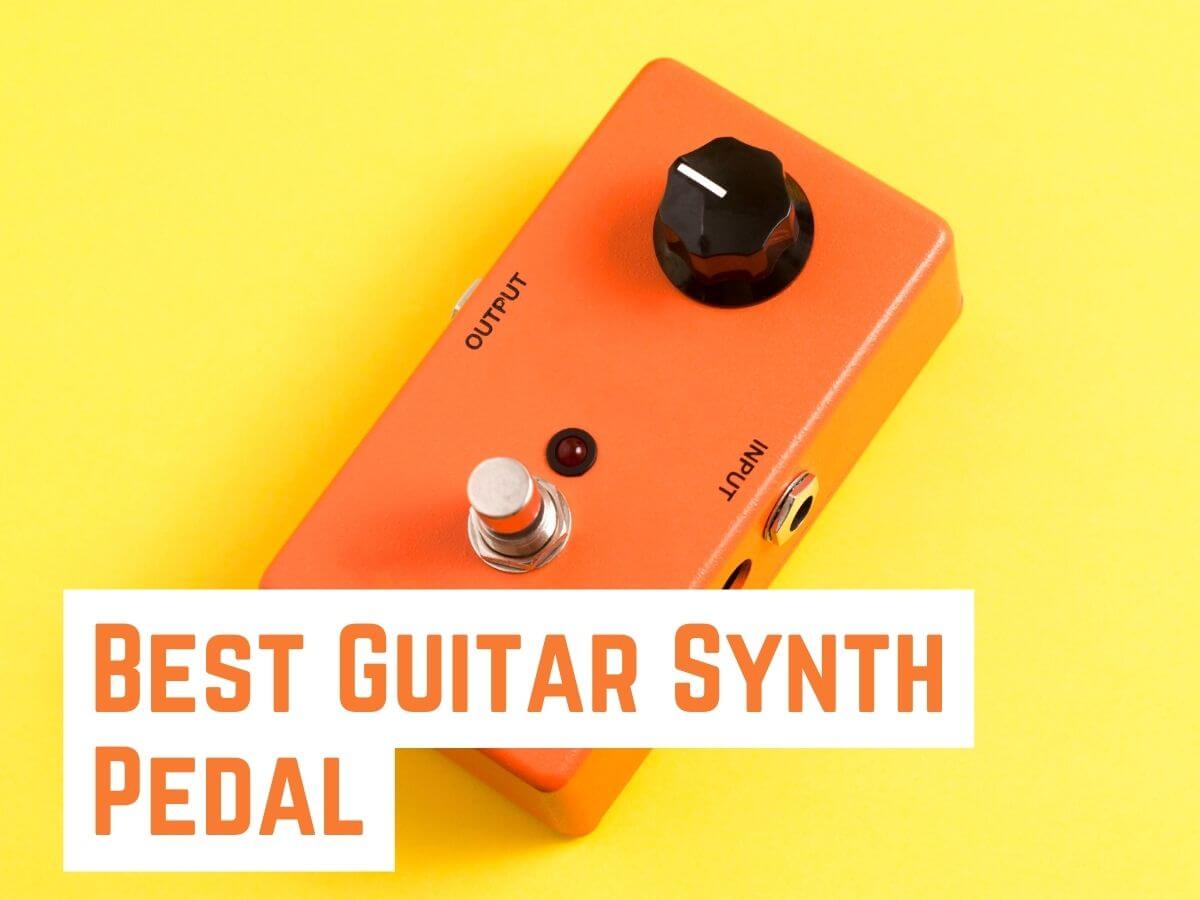
Have you ever felt like playing a synthesizer, but on your guitar? Synthesizers have existed since the ‘70s, capable of fascinating and unique sounds. With modern technology, it’s now possible for guitarists to take advantage of these electronic, futuristic-sounding instruments and achieve new sounds that aren’t normally possible on a guitar.
We’ve researched and rounded up the 10 best guitar synth pedals available today that’ll usher you into a new world of tones.
What are the Best Guitar Synth Pedal?
1. Boss SY-1000 Guitar Synthesizer Pedal – Best Overall
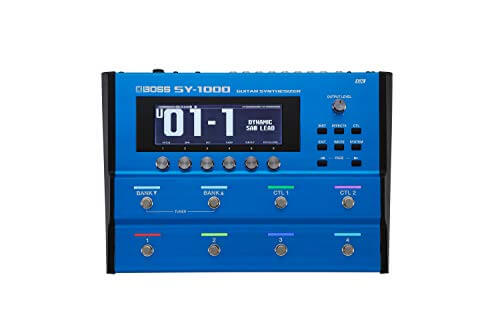
Specifications
- Modes: 3
- Controls: Output Level, 6 Edit Buttons, 6 Rotary Knobs, 8 Footswitches
- Bypass: Buffered
- Power: AC Adaptor
Boss is a renowned name in the world of guitar effects, amp modeling, and producing innovative new technology. They were also one of the first to produce guitar synth pedals, with the GR-500. The newly released Boss SY-1000 is a direct upgrade over its predecessor, the Boss SY-300, and it brings with it a whole slew of modern technology that combines effects, amps, and analogue synth tones in a single unit.
The SY-1000 has 3 primary synth modules – a dynamic synth module, an OSC synth, and a GR300. These synth modules are very powerful, driven by 48kHz/32bit processing, and the pedal can run three voices concurrently.
It features many amp models for guitar, acoustic, and bass, along with over 150 effects, taken from their flagship GT-1000 unit. If you use the Roland GK pickup system, its capabilities get enhanced even further with alternate tunings, monophonic and polyphonic operation, and more. Here’s what guitarist Rabea Massaad had to say about it :
The thing that’s impressed me the most, genuinely, is the latency.
The SY-1000 tracks incredibly well, much better than the guitar synth pedals that have come before it. Its guitar-to-MIDI conversion is superb as well, so you can record it directly into a DAW with low-latency and accuracy. With over 200 presets and 200 user patches onboard, you can fine-tune your sound exactly as you need it and organize them for easy access.
The SY-1000 also features an easy-to-use and intuitive interface that lets you make patches the way you want them, and quickly. It has a range of input and output options, with a 13-pin GK input, FX loops, USB connectivity, and much more. It requires an AC adaptor for its power supply.
If you want the best guitar synth pedal, then the Boss SY-1000 is your best bet. With amazing analog synth emulations, a range of instrument options with many effects, fast and accurate tracking (both with and without the GK pickups), and the fact that it doubles as a multi-effects guitar processor, this pedal may be an expensive investment for any musician, but well worth it in the long run.
2. MOOER E7 Polyphonic Guitar Synth Pedal – Budget Pick
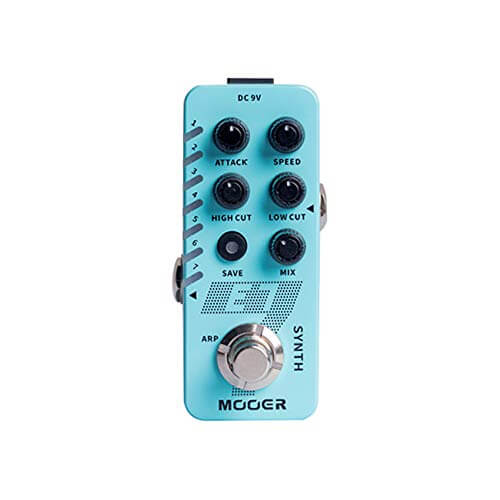
Specifications
- Modes: 7
- Controls: Attack, Speed, High Cut, Low Cut, Mix, Save
- Bypass: True
- Power: 9V PSU
Mooer’s pedals have become very popular amongst guitarists, as they offer great quality at an affordable price. As a part of their new Micro series, the E7 is a polyphonic guitar synth effects pedal that offers a lot of classic synth tones in a very portable and easy-to-use stompbox format.
The Mooer E7 has 7 LEDs on its side to indicate the 7 modes available here. There are 5 knobs that can be used to adjust the Attack, Speed (of the arpeggiator), High Cut, Low Cut, and Mix, along with a Save button that’s also used to switch presets. The modes available here represent a variety of sounds, including analog synths, EDM tones, synth pads, ‘weevo’ effects, and more.
The E7 is a small pedal and will easily fit on any pedalboard. The footswitch is easy to access, and the LEDs give you information on the currently selected preset. There is a USB port available here for firmware updates. It requires a 9V power supply for operation, and also features true analog bypass.
If you’re looking for a simple and affordable way to explore the world of guitar synthesizers, then the Mooer E7 is a great choice. With 7 classic modes that offer a lot of sonic potential, easy to use controls, and a compact shape, this synth stompbox is definitely worth a try, especially if you’re a beginner.
3. BOSS SY-1 Guitar Synthesizer Pedal – Most Compact
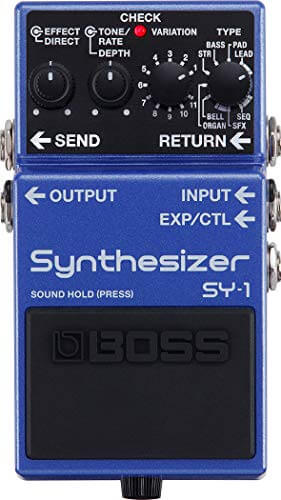
Specifications
- Modes: 11
- Controls: Effect, Direct, Tone, Rate, Depth, Type, Variation
- Bypass: Buffered
- Power: 9V DC PSU or Battery
The Boss SY-1 is another release from Roland, and it’s a very compact synth pedal in a classic stompbox format. It takes its inspiration from the Boss SY-300 but offers a similar experience in a much smaller pedal, and it works well without the need for any special pickups like the GK system.
The SY-1 has 11 modes that include Lead, Bell, Organ, Pad, and more, with each of these modes having 11 variations for a total of 121 sounds! This gives you a lot of possibilities to play around with. The tracking is great and doesn’t suffer from any noticeable latency, and it picks up your playing dynamics quite well. There’s even a hold function to sustain a synth sound while you play a lead line.
The best part about the SY-1 is it’s easy to integrate it into an existing pedalboard setup, unlike many other synth systems. It’s easy to dial in a tone using the standard knobs, and the stomp-switching makes it quick to switch between a guitar tone and a synth tone. It works well for both bass guitars and normal guitars, with polyphonic tracking.
Since it’s built like a classic Boss pedal, it’s very rugged and durable, and compact enough to fit most pedalboards. It has a range of I/O options, including an FX loop and expression jack for easy connectivity to external pedals. It can be powered by a 9V battery or power supply, and it has a buffered bypass.
If you’re looking for a compact guitar synth pedal to integrate into your existing setup, then the Boss SY-1 is a fantastic option. It’s lightweight, easy to use, tracks fast, and has great synthesizer sounds without a special pickup. From the people who created guitar synths, this is a pedal that simply does not disappoint, and it’s a worthy option if the SY-300 or SY-1000 are too expensive for you.
4. MOOER GE300 Amp Modelling Processor Multi-Effects Guitar Synth Pedal – Most Versatile
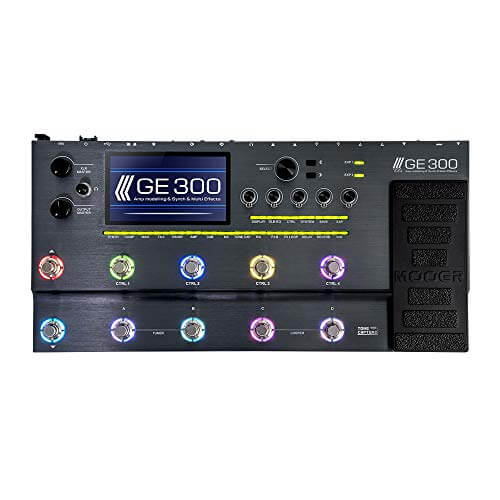
Specifications
- Modes: 3
- Controls: Master Volume, 10 Footswitches, Edit Buttons, Module Buttons, Expression Pedal
- Bypass: Buffered
- Power: 9V, 3A DC PSU
The second pedal on the list by Mooer, the GE300 is their flagship multi-effects and amp modelling pedal that’s been designed to take on the Fractal Axe FX series, Kemper, Helix, and other amp profilers. It’s a complete single-unit solution to a guitarist’s tonal needs, but it also has an interesting synth engine that takes it above and beyond others.
The GE300 has a tri-voice synthesizer module that can be added to any block in your signal chain, while the input stays the first. There are a range of parameters to adjust here, including waveform, oscillation, attack, pitch, filter, and much more. You can split the synthesizer into 3 different parallel chains, each with its own settings, to make for some really cool-sounding effects. You can even mix this with a classic guitar tone for more tonal possibilities.
Besides the amazing synth effects module that can replicate classic analog synthesizer tones like square leads, pads, strings, and more, the GE300 is also fantastic as an amp modeller. With over 108 amp models, over a hundred onboard effects, and the ‘Tone Capture’ functionality that lets you profile your own amp, this multi-fx pedal can serve pretty much any purpose you could think of. According to guitarist Karl Golden :
There are so many tonal options with this GE300. It’s simply amazing.
If you’re looking for a multi-effects pedal that also has synthesizer functionality, you should definitely check out the Mooer GE300. Its tri-voice synth sounds great, and with all of its onboard amps and effects, the extensive connectivity options, MIDI and USB interface, and in-built expression pedal, the GE300 can replace your entire pedalboard and allow you to truly explore a new world of tones.
5. Source Audio C4 Synth Guitar Effect Pedal – Most Innovative
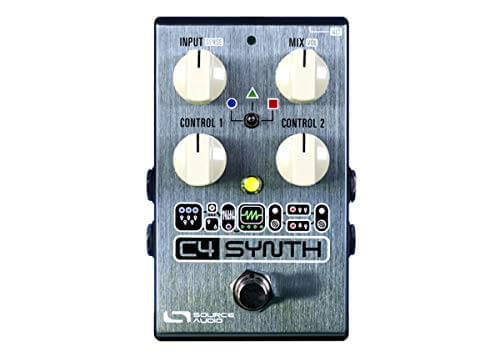
Specifications
- Modes: 4
- Controls: Input, Mix, Control 1, Control 2, Alt, Mode Switch
- Bypass: Universal
- Power: 9V DC PSU
Source Audio has been a powerhouse of innovation in the world for guitar effects for several years now. Their ‘One’ series of pedals feature some really unique and cool features that make guitarists’ lives much easier and let them explore new tones. The Source Audio C4 guitar synth pedal is one of their latest releases, and it’s one hell of a synth pedal.
The C4 has just four knobs on its front – Input, Mix, and two user-assigned Control knobs. There’s also an Alt button that gives you access to more controls like Sense and Volume, while the toggle switch lets you choose between the 3 available factory modes. There are 128 presets here, which can be accessed using MIDI. The synth engine has multiple effects processors which can produce 4 voices that can be assigned anything from oscillators and pitch-shifters to harmonizers and sequencers.
The C4’s true power comes from Source Audio’s Neuro Editor, which is available for desktops and mobiles. This lets you dive deep into the settings, and fine-tune your sound to perfection. With 3 wave shapes, 11 envelopes, 24 filters, 14 LFOs, and two 16-step sequencers, there’s more than enough available here to tweak your own signature sound. Plus, you can download user presets from the cloud too.
This pedal comes in a very durable aluminum housing and can easily fit most pedalboards. It has stereo inputs and outputs, with a USB port and a MIDI jack as well. It has a universal bypass, so you can choose between true-relay or analog-buffered as you wish. It requires a 9V DC power supply for its operation.
If you want a really clever new piece of gear that has both classic and modern synth sounds, then the Source Audio C4 synth pedal is a fantastic choice. Its quadruple-voiced synth engine delivers more power than almost anything else in the market, and with the app-based editing, making new tones and browsing presets is quick and easy for anyone.
6. Empress Effects ZOIA Modular Synthesizer and Guitar Multi-Effects Pedal

Specifications
- Modes: 1
- Controls: Select, Scroll, Scroll Wheel, 40 Module Buttons, Edit Buttons, OLED Display
- Bypass: Buffered
- Power: 9V DC PSU
The Empress Effects ZOIA has been a head-turner in the guitar world; its release was much anticipated by guitarists all over the world. Empress Effects has a reputation for building high-quality pedals with innovative effects, and the ZOIA does not disappoint. It’s a truly modular synthesizer, designed to give you complete control over your tone.
The ZOIA features over 80 in-built modules, featuring oscillators, LFOs, filters, envelope followers, bit crushers, and more, that can be put together in any way you like. On top of that, there are 20 guitar effects like reverb, delay, flanger, phaser, and more, for more ready-made tones. Between the 64 onboard patches and the three footswitches, you can easily change your tones during a live performance.
Initially, it can be quite difficult to wrap your head around the ZOIA’s immense potential. But with the inbuilt help section, the OLED display, and some time spent tweaking presets, you can truly harness its raw modular synthesis power. From square-wave leads like a Moog, or lush, ambient pads, or 8-bit Nintendo-style sounds, you can achieve pretty much anything, all in 48kHz, 32-bit audio.
If you want a powerful modular synthesizer in the form of a guitar pedal, then you should definitely get the Empress Effects ZOIA. With so many in-built modules that keep getting updated, a fully tweakable approach to synth sounds, SD Card and MIDI connectivity, and a rock-solid design, the ZOIA is a true delight for any tone connoisseur.
7. Meris Enzo Multi-Voice Instrument Synthesizer Pedal
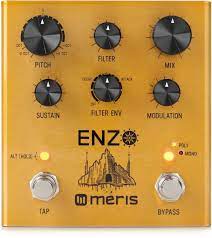
Specifications
- Modes: 4
- Controls: Pitch, Filter, Mix, Sustain, Filter Env, Modulation, Tap Tempo
- Bypass: True or Buffered
- Power: 9V DC PSU
Meris is known for making premium effects with superb attention-to-detail and high-quality tones. The Meris Enzo is their take on a guitar synthesizer pedal, featuring multiple voices and several in-built effects that prove it to be a powerful tone-shaping tool for any guitarist. Much like the Keeley Synth 1, it comes packed with multiple waves, filters, and envelopes.
The Meris Enzo has 4 operating modes: monophonic for leads, polyphonic for chords, arpeggiator, and a dry pitch-shifter. With the 6 control knobs on its front, along with the Alt button, you have access to a range of different controls on the pedal itself. It has a +/- 2-octave pitch-shift range with a 6-mode envelope filter with adjustable bandwidth and frequency, and even a ring modulator. This is truly a gift for the sonic explorers inside us.
Getting a hang of the multitude of controls available here can take some time, but it’s well worth it. The Enzo tracks blazingly fast, especially on a neck pickup, converting your guitar to synth sounds in real-time with amazing accuracy. With stereo outputs and MIDI connectivity, you can expand the pedal’s functionality even further and navigate the 16 presets onboard. The bypass is switchable between true and buffered as well.
If you’re looking for a beautiful, premium guitar synth pedal, then the Meris Enzo is for you. With the vibrant gold coating on its aluminum chassis, it looks as gorgeous as it sounds, and with expandable connectivity via MIDI, expression pedal support, portamento control and infinite sustain, and inbuilt effects, the Enzo is a true example of engineering excellence in guitar effects.
8. Electro-Harmonix SYNTH9 Synthesizer Machine
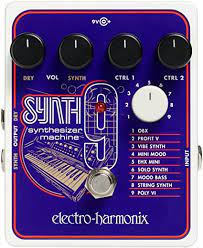
Specifications
- Modes: 9
- Controls: Dry, Synth, Ctrl 1, Ctrl 2, Mode
- Bypass: Buffered
- Power: 9V DC PSU
New-York based Electro-Harmonix is a well-known name in the guitar effects community, and they’ve recently been launching a range of ‘9’ pedals, emulating various instruments like organs, pianos, Mellotrons, and more. Now, a successor to the Electro-Harmonix SuperEgo, comes the Synth9 synthesizer machine, designed to provide you with some classic analog synth sounds in a guitar pedal format.
The Synth9 has a very simple layout, with just four knobs on its front and a Mode dial. The knobs adjust Dry and Synth levels, while the Ctrl 1 and 2 knobs change parameters based on the selected mode. There are 9 modes available here, which emulate a range of vintage synths like the Prophet V, Moog, and more. These sound fantastic, and the tracking is very fast and accurate.
Much like the Electro-Harmonix SuperEgo, the Synth9 also features some cool, futuristic artwork on its metal chassis. It has stereo outputs so you can mix your wet and dry signal together, and buffered bypass. It requires a 9V DC power supply for its functioning.
If you’re looking for a great-sounding guitar synth pedal that’s quick and easy to use, then the Electro-Harmonix Synth9 is a great option. With 9 different synthesizer modules that replicate some classic tones and really easy to use controls, this synth pedal is a fantastic upgrade over the Electro-Harmonix SuperEgo, and it’s great for plugging your guitar in and jamming without having to fiddle about too much.
9. DigiTech Dirty Robot Stereo Mini-Synth Pedal
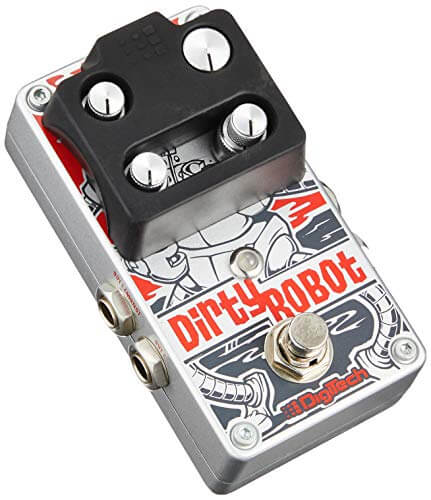
Specifications
- Modes: 2
- Controls: Mix, Modulation, Sensitivity, Drift, Start/Stop, Time, V1/V2
- Bypass: True
- Power: 9V DC PSU
DigiTech is known amongst the guitar player community for making some great effects pedals at affordable prices. The DigiTech Dirty Robot is a synthesizer pedal designed by them that offers two different synth voices, and accurate tracking without the need for any special pickup. It can integrate into any existing pedalboard setup with ease.
The Dirty Robot has two synth voices labeled as V1 and V2, which can be chosen through the toggle switch on top. V1 offers a warm, analog synthesis that emulates synthesizers from the ’70s and ’80s, whereas V2 offers a vocoder, talk-box style effect. The Drift knob alters the square-wave and octave effect, and there’s even in-built chorus and vibrato that can be accessed through the Modulation knob.
DigiTech have built the Dirty Robot with a durable metal chassis, and it’s compact enough to fit most pedalboards. It has stereo inputs and outputs, with an LED indicator for the power state. It also features a true bypass when disengaged, and it requires a 9V DC power supply for its operation.
If you’re looking for a simple synth pedal that emulates classic ‘70s analog synths as well as vocoders, then you should give the DigiTech Dirty Robot a try. With two voicings, easy-to-use controls, true hardwire bypass, and a cool, compact design, it’s definitely a pedal worth exploring for guitar synth enthusiasts.
10. EarthQuaker Devices Data Corrupter Guitar Effects Pedal
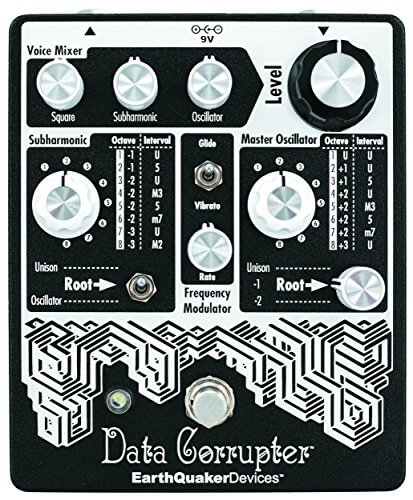
Specifications
- Modes: 3
- Controls: Square, Subharmonic, Oscillator, Level, Rate, Glide/Vibrato
- Bypass: True
- Power: 9V DC PSU
EarthQuaker Devices are known for making high-quality, handmade effects pedals with innovative features and cool designs. The EQD Data Corrupter is their take on a synth, fuzz, and octave pedal all in one. It’s capable of producing some really wild and unique tones, and it can add a lot of flavor to your guitar tone.
The Data Corrupter has a range of controls onboard that can seem a bit daunting at first. You have three knobs for mixing the 3 different voices – Square, Subharmonic, and Oscillator. These voices have individual controls to change their sound, such as unison, and the root note, as well as the rate. The Glide mode activates a portamento-style effect, while the Vibrato adds frequency modulation.
The overall sound of the Data Corrupter is very aggressive, with a distorted, fuzzy tone and a psychedelic feel to it, much like the Keeley Synth 1. The pedal has a similar, erratic artwork on its metallic chassis. It only has mono inputs and outputs, a true hardwire bypass with a latching system, and it requires a 9V power supply for its operation.
If you’re looking for a fuzzy synth pedal with otherworldly sounds, you should definitely give the EarthQuaker Devices Data Corrupter a try. It’s not a usual synth pedal, in that it offers a very distorted tone with multiple octaves and harmonies for a very unique tone, and it works just like a normal guitar pedal with other pedals in your setup. A must-try for psychedelic tone explorers!
What To Know Before Buying a Guitar Synth Pedal?
Sound And Modes
When considering guitar synthesizer pedals, the most important factor to look at is the sound. Different synth pedals have different types of synthesizer modules based on different synthesizers like leads, pads, strings, bit-crushers, etc., with different oscillators and wave-shapes that result in different sounds .
Synth pedals may have different algorithms, including analog, modular, or digital, all of which affect the sounds produced by them.
Different guitar synthesizer pedals also have varying modes and voices. Some of them have a few different modes to choose from, whereas others have dozens of variations. Pedals like the C4 can run four voices simultaneously, allowing you to combine four synth tones together, while some may have fewer voices. Hence, it’s important to understand the different sounds you’ll have available with each pedal.
So when considering a guitar synthesizer pedal, consider the type of sound you’re going for. You may prefer an analog synth tone like a ‘Moog’, or you may want a violin-like tone, or even a radical, distorted tone. We recommend you to try out some of these guitar synths at a local store if possible, or watch some online demo videos to gain a better understanding of each pedal’s capabilities.
Tracking And Playability
The term ‘tracking’ refers to the synth pedal’s ability to recognize the notes you’re playing and convert them to synth sounds in real-time. The best pedals can track very accurately with minimal latency, but this differs from pedal to pedal. Some may even require a special pickup system, such as the Roland GK pickup, to track faster and more accurately.
Tracking may also be ‘monophonic’ or ‘polyphonic’. Monophonic refers to tracking only one note at a time, which is great for synth leads and solos. Polyphonic refers to tracking chords and complex arpeggios, which is great for rhythm sections. You should make sure the pedal you get is capable of tracking what you want to play, as not all pedals track equally well.
Hence, the playability of synth pedals is a major factor. Guitar synthesizer pedals have existed for over 40 years now, but the technology keeps improving with new products. This also depends on their position in the signal chain, and other pedals in the pedalboard. The best way to find out is to try them yourself, and see if they can keep up with your playing.
Controls
The synth pedals on this list come with a lot of different control options; some have just a few easy-to-use knobs, while others have in-depth app-based editors and several parameters to configure your tone precisely.
Synth pedals may even have different in-built effects like choruses, vibrato, octaves, pitch-shifters, harmonizers, etc., which expands the versatility of the pedal.
Hence, it’s important to know what controls are available on hand for you to tweak your tone to perfection. You may prefer a simpler pedal like the Boss SY-1, which offers great tones without too much tinkering, or you may want a pedal like the Source Audio C4, which lets you tweak every aspect of the pedal till you find your desired tone. Ultimately, you have to be comfortable with the pedal so you can spend less time tweaking it and more time playing your guitar!
FAQs
What does a synth pedal do?
A synth pedal takes the signal from your guitar, recognizes the notes you’re playing, and uses that to convert it to a synthesizer sound. It uses oscillators and synthesizer circuits, which may be digital or analog, to generate sound based on the signal it’s receiving. Unlike most other pedals, synth pedals do not alter your guitar tone, and instead create a new signal that can run in parallel with a standard guitar tone.
Where should synth pedal go in chain?
A synth pedal should go near the beginning of your chain. Ideally, it should be the first pedal, so that it gets a completely clean signal. This makes the tracking process easier and more accurate. Some people prefer to use a compressor before the synth for more sensitive tracking. Since most synth pedals have stereo outputs, you can route these pedals through your pedalboard in multiple different ways.
How do I make my guitar sound like a piano?
You can make your guitar sound like a piano using synth pedals and MIDI. Some pedals, like the Boss SY-1000 with the GK pickup system, let you convert your guitar signal into MIDI. With this, you can use piano software to emulate the sound of a piano and achieve quite interesting results.
